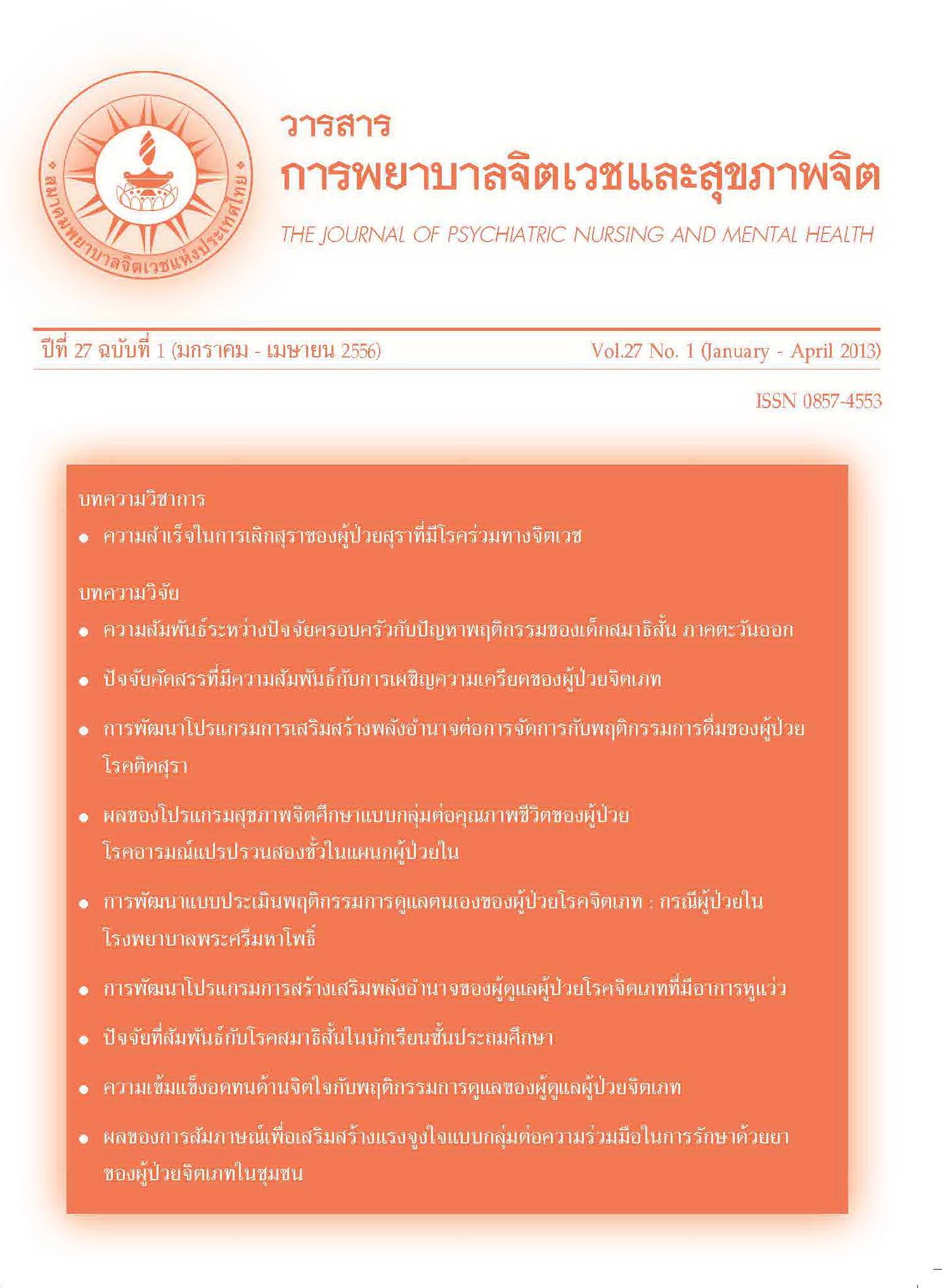การพัฒนาแบบประเมินพฤติกรรมการดูแลตนเองของผู้ป่วยโรคจิตเภท : กรณีผู้ป่วยใน โรงพยาบาลพระศรีมหาโพธิ์
Main Article Content
บทคัดย่อ
บทคัดย่อ
การวิจัยและพัฒนาครั้งนี้ มีวัตถุประสงค์เพื่อพัฒนาแบบประเมินพฤติกรรมการดูแลตนเองและตรวจสอบคุณภาพของแบบประเมินด้านความเที่ยงตรงตามเนื้อหา ความเที่ยงตรงเชิงโครงสร้าง และความเชื่อมั่นของแบบประเมิน และทดสอบคุณภาพของแบบประเมินด้านความเที่ยงตรงตามเกณฑ์สัมพันธ์โดยเปรียบเทียบค่าคะแนนระหว่างแบบประเมินพฤติกรรมดูแลตนเองที่ผู้วิจัยพัฒนาขึ้นและแบบประเมินความสามารถในการใช้ชีวิตโดยทั่วไป กรอบแนวคิดได้รับการพัฒนาจากการประยุกต์แนวคิดการดูแลตนเอง (Orem,1985) และข้อมูลจากการสัมภาษณ์พยาบาลผู้ดูแลผู้ป่วยโรคจิตเภท กลุ่มตัวอย่างคือ ผู้ป่วยโรคจิตเภทที่เข้ารับการรักษาแบบผู้ป่วยใน จำนวน 300 คน เครื่องมือรวบรวมข้อมูลคือ แบบประเมินพฤติกรรมการดูแลตนเองของผู้ป่วยโรคจิตเภท ที่ผู้วิจัยพัฒนาขึ้น และแบบประเมินความสามารถในการใช้ชีวิตโดยทั่วไปของผู้ป่วย วิเคราะห์ข้อมูลองค์ประกอบเชิงสำรวจด้วยเทคนิค Principal Component และทดสอบสมมติฐานด้วยสถิติสัมประสิทธิ์สหสัมพันธ์แบบเพียร์สัน ผลการวิจัยสรุปได้ว่า
1. ค่าความเที่ยงตรงตามเนื้อหาของแบบประเมิน มีค่าความสอดคล้องระหว่างข้อคำถามและวัตถุประสงค์ อยู่ระหว่าง 0.70 -1.00
2. ความเที่ยงตรงเชิงโครงสร้าง มี 6องค์ประกอบ คือ 1) การมีปฏิสัมพันธ์กับผู้อื่น (จำนวน 5 ข้อ) มีค่าน้ำหนักองค์ประกอบอยู่ระหว่าง 0.74 – 0.89 2) การออกกำลังกาย (จำนวน 5 ข้อ) มีค่าน้ำหนักองค์ประกอบอยู่ระหว่าง 0.51 – 0.78 3) การดูแลสุขอนามัยส่วนบุคคล (จำนวน 4 ข้อ) มีค่าน้ำหนักองค์ประกอบอยู่ระหว่าง 0.54 – 0.89 4) การพักผ่อนนอนหลับและการขับถ่าย (จำนวน 4 ข้อ) มีค่าน้ำหนักองค์ประกอบอยู่ระหว่าง 0.51 – 0.86 5) การดูแลสุขอนามัยส่วนบุคคลและการพักผ่อนนอนหลับ (จำนวน 4 ข้อ) มีค่าน้ำหนักองค์ประกอบอยู่ระหว่าง 0.52 – 0.78 และ 6) การรับประทานอาหารและยา (จำนวน 3 ข้อ) มีค่าน้ำหนักองค์ประกอบอยู่ระหว่าง 0.55 – 0.79 และค่าสัมประสิทธิ์แอลฟาของแบบประเมิน ทั้งฉบับมีค่าเท่ากับ .96
3. แบบประเมินพฤติกรรมการดูแลตนเองของผู้ป่วยโรคจิตเภทที่พัฒนาขึ้น และ แบบประเมินความสามารถในการใช้ชีวิตโดยทั่วไปมีค่าสหสัมพันธ์เชิงบวก อย่างมีนัยสำคัญทางสถิติ (r = .74, p< .001)
คำสำคัญ : แบบประเมินพฤติกรรมการดูแลตนเอง, ผู้ป่วยโรคจิตเภท, แผนกผู้ป่วยใน
Abstract
The purposes of this research and development were to develop the assessment tool for self care behavior of Schizophrenic patients and to verify the tool’s quality of content validity , construct validity, reliability and criterion validity. The conceptual frameworks were developed from Orem’s self care anddata of nurses’ interviews. Two stages of this research were: 1) The assessment tools for self care behavior of schizophrenic patients was developed, 2) The quality of the assessment tool was verified. Subjects were 300 Schizophrenic patients, in-patient department of psychiatric hospital. Exploratory factor analysis by the principal component technique was used. Hypothesis was tested using Pearson’s correlation. The results were concluded:
1) The Item Objective Congruence of the assessment tool was ranged between0.70-1.00
2) The construct validity of the assessment tool comprised six factors: 1) The interpersonal relationship (5 items) with the factor loading range between 0.74 – 0.89, 2) Exercise(5 items) with the factor loading range between 0.51 – 0.78, 3) Personal hygiene care (4 items) with the factor loading range between 0.54 – 0.89, 4) Sleep and elimination (4 items) with the factor loading range between 0.51 – 0.86,5) Personal hygiene care and sleep (4 items) with the factor loading range between 0.52 – 0.78, and 6) Eating food and take medicine(3 items) with the factor loading range between 0.55 – 0.79. Also, the Cronbach’s alpha coefficient of the total item is 0.96.
3) The assessment tool and Global Assessment of Functioning Scale is positively significant correlate (r = .74, p< .001).
Key words : assessment tool for self care behavior, schizophrenic patient, in-patient department
Article Details
บทความที่ได้รับการตีพิมพ์แล้ว เป็นลิขสิทธิ์ของสมาคมพยาบาลจิตเวชแห่งประเทศไทย

